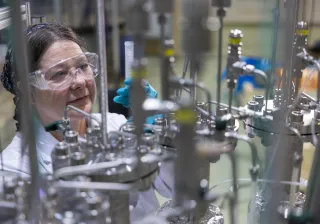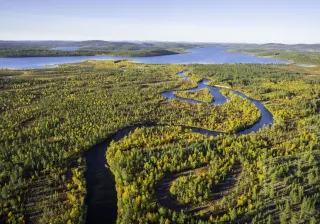It's a scene familiar to us all. You unpack your new TV, washing machine, or flat-pack table and you're left with a mountain of expanded plastic foam to dispose of – and maybe a nagging sense of guilt that it can sit in your local landfill site for decades to come.
If only there was an eco-friendly alternative that not only keeps goods safe during transport and storage, but which can be easily recycled using existing infrastructure – or even composted at home. The good news is that this alternative already exists: packaging material created from a renewable material: wood.
Expanded polystyrene (EPS) packaging is a big problem. Its bulk, and limited recycling infrastructure means EPS is difficult to get rid of. In the near future, pressure from consumers, brand owners, and governments will force packaging companies to create cushioning that is made from more sustainable materials. The EU plastic strategy focuses on achieving 100% recyclability, reusability, or compostability by 2030, and major cities like New York and San Francisco have attempted to limit or ban the use of polystyrene foam products in food packaging.
Some of the world's biggest brands are also seeking more eco-friendly packaging and cushioning options – for example, McDonald's announced that they will stop using polystyrene foam cups by the end of 2018. Following a push from the Ellen MacArthur Foundation, 11 leading companies – including global heavyweights like Evian, L'Oréal, Mars, The Coca-Cola Company, Unilever, and Walmart – have announced that they aim to adopt 100% reusable, recyclable, or compostable packaging by 2025.
And it's not hard to see why. Pernilla Ståhle, R&D Director at Swedish pulp and paper manufacturer BillerudKorsnäs, explains: "The direction we see is that consumers are much more aware of climate change and the growing problem of plastic in our oceans. People tend to actively avoid packaging if possible or else pick a sustainable choice of material."
The search for a more sustainable solution
The current solutions for replacing some forms of EPS packaging are polylactide (PLA) foams, for example made from corn, and corrugated board and molded fibre products made from wood pulp; all have benefits and drawbacks. PLA has good water resistance and offers similar performance to EPS. It looks so similar to EPS packaging that the average consumer often can't tell the difference and may not even realize it is compostable. However, PLA is currently about twice as expensive to produce as EPS, and while EPS- and PLA-based packaging and cushioning could be recycled, there is no easy existing recycling infrastructure available in all countries that consumers can use to dispose of the material. PLA is also difficult for consumers to compost because it needs higher temperatures than can typically be reached in a home composter. Luckily, a significant proportion of the biowaste collected by EU citizens is utilized in industrial composting.
In contrast to PLA, corrugated board and molded fibre packaging and cushioning can be disposed of through existing paper recycling programs; neither, however, offer the same level of protective cushioning or thermal properties as EPS.
EPS finally meets its match
VTT has developed a foam-formed cellulose-based material that is an attractive alternative to EPS. The material is based on 100% renewable material – wood pulp – and can be recycled in the same way as cardboard. The packaging and cushioning material can also be burned or composted like paper.
In addition to being eco-friendly, foam-formed cellulose-based materials offer key technical benefits compared with the current alternatives. For example, the foam-forming technology allows short and long fibres to be combined to improve the mechanical performance of the foam, providing better protection. What's more, cellulose fibres can be combined with polymer or biopolymer fibres for even greater versatility. Foam-formed cellulose-based materials also look like a paper product, meaning consumers can instantly see that the brand has replaced bulky and hard-to-recycle EPS with an easily recyclable and renewable alternative.
"Smart fibre-based packaging creates value all the way from the raw material to the consumer," says Ståhle, "Our challenge is to combine advanced new materials with our existing fibre materials to create competitive alternatives to fossil-based plastic."
Other elements can be incorporated into the foam, for example a cellulose-PLA foam composite for delicate applications that require a material with excellent cushioning performance. The thermal stability of cellulose-based foams are also better than PLA foams, which means they can be used in hot environments, or to pack products that are still warm from production. Depending on the application, cellulose-based foams can even be produced with existing paper infrastructure to create products such as bio-based board, cushioning materials, non-woven web, and insulation.
But what about the cost?
"From an economic perspective, once cellulose-based foam production is upscaled and becomes mainstream, we expect the price to be reasonable and lower than PLA," says Harri Kiiskinen, Principal Scientist from VTT.
Taking bio-based packing and cushioning mainstream
So far so good, but how practical is it for companies to make the switch to bio-based alternatives?
Currently, VTT offers pilot-scale production of web-like materials and laboratory-scale demonstrations of its bio-based packaging, and is working on upscaling the technologies. For dry packaging and applications that require thinner cushioning materials, the available industrial-scale foam-formed cellulose-based materials can already be used as a like-for-like replacement. Research and development work is ongoing to solve the remaining technical challenges, such as the drying of very thick foams to remove excess moisture without loss of bulk.
"Cellulose is a very promising replacement for EPS in several applications. At the moment, we can offer a pilot at our laboratories where our researchers will create a bio-based foam with physical and mechanical properties tailored to a customer's specific need," says Kiiskinen.
"We've been researching and developing the technology needed to create fibre foams for over 10 years. We have unmatched expertise in this area, and we're working closely with universities, brand owners, paper companies, and manufacturing partners to upscale the technology and take it from the lab into large-scale production", he continues.
As part of making this technology commercially more viable, VTT is currently leading an EU project, which tackles the upscaling issues. The project has 33 industrial partners, whose contribution in development of the foam forming process as well as the required material solutions is central when considering the industrial implementation of the technology.
"From both an environmental and a business perspective, there is a clear need for new packaging material solutions," says Kiiskinen. "Research is ongoing to find the best solutions that can match the performance of EPS while also being eco-friendly and zero-waste. The results of our research so far suggest that bio-based packaging is going to be an integral part of our future."
Ståhle agrees: "BillerudKorsnäs is challenging conventional packaging for a sustainable future and this means that we are trying to find biobased solutions in many packaging areas. One area for example, is the growing problem of Styrofoam cups where we are trying to use biobased material from foam technology, where VTT is a strong partner."





